A hybrid with an original flavor that will pleasantly surprise you - “Hazelnut” pumpkin: we grow it without much hassle
Pumpkin is part of traditional dishes around the world. It contains many useful substances that have a positive effect on vision, stomach, intestines, immunity and metabolic processes. Therefore, it is actively grown by gardeners around the world, including in our country.
Breeders produce new ones every year varieties and hybrids, characterized by ease of care and unusual taste. The achievements of agronomists also include the Hazelnut pumpkin. This hybrid is resistant to many diseases and has a nutty aftertaste. Read on to learn how to grow it on your own property.
general description
Hazelnut pumpkin is a hybrid. It was bred by crossing two varieties. Planting seeds from fruits is impossible, since the plants grown from them retain their parental characteristics.
This hybrid appeared on the markets a long time ago. It has already become a favorite among gardeners around the world. Many domestic companies also produce it.
Distinctive features
Hazelnut pumpkin has dense but juicy pulp with a high starch content. It has a pleasant taste with a nutmeg aroma and a nutty aftertaste. There are few sugars in its fruits, so there is no pronounced sweetness.
The fruits also look very unusual. In appearance, they resemble hazelnuts. They even have a dark ring at the tip. The color of the pumpkin is red-orange. Look what this vegetable looks like in the photo.
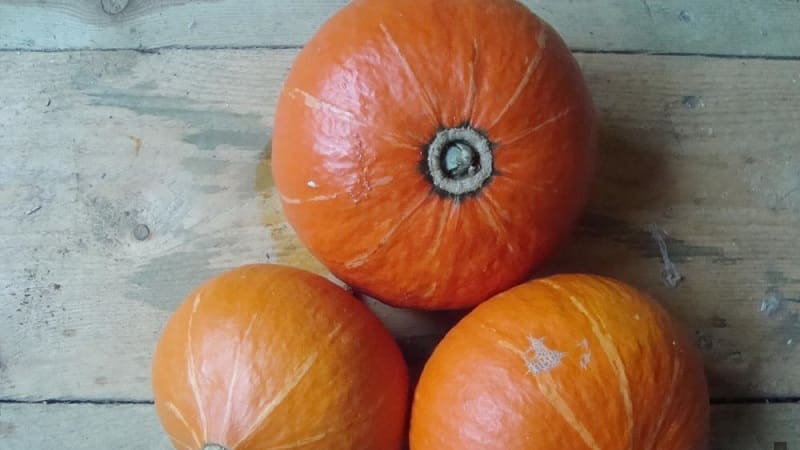
The fruit size is smaller than many other varieties. On average, the weight of one pumpkin reaches only 1 kg. They have a durable shell and are stored for a long time.
Despite the fact that the homeland of melons is the tropics, Hazelnut tolerates temperature fluctuations well. If the summer is not hot, then the yield of this hybrid will be less.
Main characteristics
Hybrid Hazelnut has a pleasant taste that will be an excellent accent to many dishes. The characteristics of this pumpkin allow even novice gardeners to grow it.
Description of Hazelnut:
| Options | Indicators |
| Bush type | Massive. Produces long creeping loops that reach 4-5 m. The leaves are bright green and large. Powerful roots go underground to a depth of 4 m. A large number of small roots are formed near the surface. The peduncle is thick and strong. |
| Fruit | Medium size. One pumpkin reaches a mass of 800-1000 g. There are specimens weighing 1.5 kg. The peel color is red-orange, with lighter stripes. The tip of the ring is dark brown and light brown. There is a lot of dark orange pulp. It is dense, but tender. Not many seeds. The shape of the fruit is round, with a slightly elongated base and a prominent tip, reminiscent of a hazelnut. The pumpkin tastes moderately sweet, with a nutmeg aroma and a nutty aftertaste. Contains an increased amount of starch. |
| Ripening time | Early hybrid. After sowing the seeds, the growing season lasts 90-100 days. |
| Transportability | High. The fruits have a durable skin that allows them to be transported over long distances. This pumpkin can be stored for more than six months. |
| Productivity | 1-4 pumpkins ripen on one plant. In hot summers, the formation of 6-7 fruits is possible. |
| Immunity | Has average immunity to many diseases of melons. Rarely, the hybrid is affected by powdery mildew, ascochyta blight, anthracnose and black mold. |
Agricultural technology
Hazelnut is a temperature-resistant hybrid. Despite this, he is light-loving. In the shade its fruits will be small and sparse.
For pumpkins, choose sunny areas of the garden. Suitable precursors for this vegetable are legumes, nightshades, onions, eggplant, beet, cabbage, carrots. You should not plant melons in beds where cucumbers, zucchini and squash previously grew.
Melon crops love fertile soils; they even grow on manure heaps. Before planting pumpkins, it is recommended to add fresh manure to the holes. The addition of ash and superphosphate is also welcome.
Beds for planting pumpkins must be disinfected by treating the soil with a solution of copper sulfate.
Note! Pumpkin can also grow in infertile soils. In this case, the fruits will be smaller and their taste less pronounced.
Landing
Pumpkin is grown in seedlings and without seedlings. The first option is suitable for the southern and central regions, and the second - for cities with cold climates.
Before sowing in any way, the seeds need to be prepared:
- Warm up. To do this, they are wrapped in thick material and placed in the sun or on a radiator. Another option is to keep the seeds in the oven for 5 hours. First hour at 20° C, then every 60 minutes. it is increased by 10 °C.
- Soak in a solution of potassium permanganate for 20 minutes.
- Soak in ash solution. To prepare it, add 1 tbsp to a glass of warm water. l. ash. The seeds are kept in this product for 12 hours. Sometimes other growth stimulants are used for these purposes.
- Temper. Seeds Place in the refrigerator for 2 days.
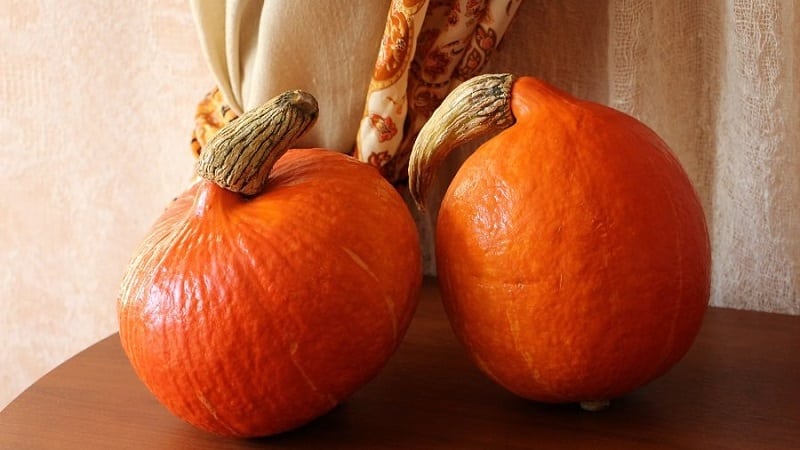
Seedling method
Pumpkin needs light and nutritious soil. You can prepare it yourself or buy it in a store. To make soil for pumpkin, mix black soil, sand and peat in equal proportions.
Both purchased and homemade soil mixtures are disinfected. The earth is calcined in the oven at high temperature, watered with a solution of potassium permanganate or boiling water.
For sowing seeds, either spacious wooden boxes or individual peat pots are used. The second method is more convenient, since you won’t have to remove the seedlings from such containers and injure the roots when transplanting them into open ground.
Containers for growing seedlings are also disinfected by soaking in a strong solution of potassium permanganate.
This is interesting! It is not necessary to check the expiration dates of pumpkin planting material. It is believed that the older the seeds, the faster they grow.
Seeds are sown in the second half of April. During the growing process, seedlings are not picked.
How to grow pumpkin seedlings:
- A 3 cm thick layer of sand is poured onto the bottom of the box or seedling pot. Then the container is filled with soil. It is moistened generously from a spray bottle with warm water.
- Seeds are planted in rows at a distance of 4 cm from each other and buried 2-3 cm.
- Boxes with seedlings are placed in a warm and well-lit place. The soil is moistened as it dries.
- Pumpkin seedlings need a lot of light. If there is not enough natural light, fluorescent lamps are used.
- 2 weeks after seed germination, the seedlings begin to harden: they are taken out into the fresh air for several hours every day.
A month after sowing the seeds, the seedlings are planted in open ground. During this procedure, it is important not to damage the roots of the plant.The distance between bushes should be at least 1 m.
Seeds
In regions with warm climates, seeds are planted directly in open ground. They germinate quickly in sun-warmed areas.
Seeds are sown in the ground when the soil warms up. The outside temperature should not be below 15 °C. This usually happens in the second half of May.
For nutmeg pumpkin, the best beds are located on a hill and well heated by the sun.
The plot of the garden for the pumpkin is dug up, clearing of plant remains. Fresh manure is spread on the ground. The soil is watered with copper sulfate.
Pumpkin holes are dug in a checkerboard pattern. The distance between rows should be at least 2 m, and between recesses - at least 1 m.
In one bed, holes are dug of different depths, from 6 to 10 cm. This will increase the likelihood that the seeds will germinate even during frost. The width of the holes should be 2-3 cm.
Place 2-3 in each well seeds, cover with earth and water generously with warm water.
The beds are covered with film. It is removed daily for several hours in the warm season to ventilate the plantings. The film is completely removed in July.
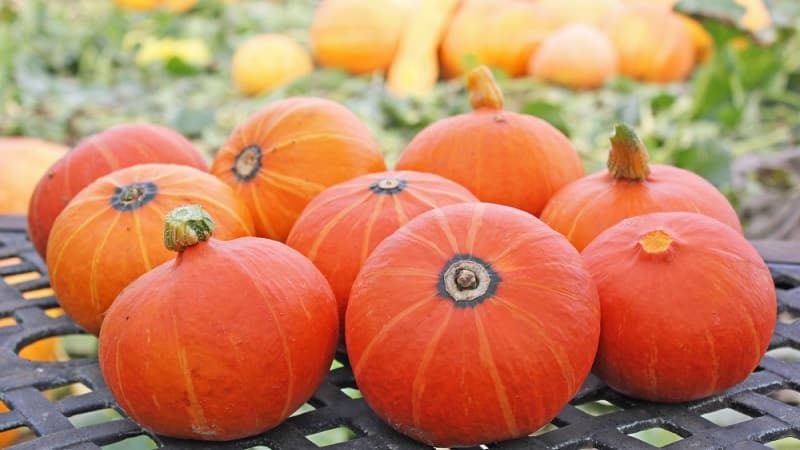
Care
Water the pumpkin with warm water infrequently, but generously. At least 2 liters of liquid are consumed for each plant. Liquid should not fall on the above-ground part of the plant. This will cause burns on the leaves and increase the risk of infection of the pumpkin.
The loops are pinched. This will allow all the formed fruits to ripen. To do this, after each ovary, 6 leaves are counted, after which the growth point of the loop is limited.
Pumpkin is demanding on soil composition. It needs to be fed every two weeks after the plants reach 1 month of age.
How to feed a pumpkin:
- The first feeding is carried out after 3-5 true leaves appear on the plants. At this stage, 10 g of dry nitrophoska is added under each bush.
- Before the inflorescences appear, the pumpkin is fed with mullein solution (take 1 kg of cow manure per 8 liters of water). Be sure to use phosphorus-potassium fertilizers.
- During flowering, the pumpkin is fed with an ash solution. For each plant take 1 tbsp. ash dissolved in 1 liter of water.
- During the period of fruit ripening, the bushes are again fed with mullein solution.
After each watering, the soil must be loosened. This helps normalize root air exchange.
It is necessary to regularly clear the beds of weeds. It is important to do this while the plants are still green. Otherwise, they will damage the pumpkin's root system.
Possible difficulties
When growing pumpkins, beginning gardeners sometimes encounter difficulties. The most common question is: why doesn't the pumpkin turn yellow? This problem occurs for several reasons:
- Lack of fertilizers. On infertile soil, pumpkins ripen more slowly. This plant needs to be fed at least 3 times per season.
- A large number of fruits. In our country, summer does not last long. If there are too many fruits, they simply do not have time to ripen. Experienced gardeners do not recommend leaving more than 2 fruits on a bush.
- Excessive amount of greenery. If you don’t plant the pumpkin, all its energy will be spent on the formation of greenery, and not on the ripening of the fruits. Therefore, excess foliage is removed.
- Lack of sunlight. Pumpkin is a light-loving plant. The more light and heat it receives, the faster its fruits will ripen. Excess foliage creates additional shading for plants.

Advice from experienced gardeners
To get large and beautiful fruits, you need to know the nuances of caring for a pumpkin. The list contains advice from experienced gardeners:
- When the pumpkin begins to turn yellow, stop watering. Otherwise, the fruits will turn out unsweetened and tasteless.
- During flowering, you need to be especially careful to ensure that the liquid does not fall on the above-ground part of the plant. If the buds are wet, the pollen will become heavy, making pollination difficult.
- The pumpkin may need artificial pollination. This procedure is carried out with a dry fluffy brush.
- In cold summers, you need to trim the shoots so that no more than 3 remain on one bush. This will speed up the formation of fruits.
Diseases and pests
Hybrid Hazelnut is resistant to most diseases. However, it is sometimes affected by powdery mildew, anthracnose, ascochyta blight and black mold.
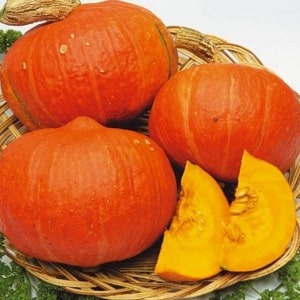 To reduce the risk of disease, you need to follow a number of prevention rules:
To reduce the risk of disease, you need to follow a number of prevention rules:
- All garden tools that come into contact with the pumpkin must be disinfected. It is necessary to disinfect the seeds, soil and containers for planting seedlings.
- Follow the rules for watering and planting plants. These procedures are carried out early in the morning or at sunset.
- To prevent damage by diseases and pests, the bushes are sprayed with a soap solution twice a season.
- To protect plants from pests that carry pathogens, they are sprayed with special agents twice a season: decoctions of celandine, chamomile, dandelion or wormwood. An ash solution is also used for these purposes.
- Large insects are collected by hand.
- To prevent rot from affecting the fruits, you need to make sure that they do not lie on the ground. To do this, pieces of plywood are placed under the fruits.
Harvesting and application
It is recommended to harvest Hazelnut pumpkin in the second half of August or the first half of September. It is cut off with a knife along with the stalk. Harvesting is carried out on dry days.
If you pick an unripe pumpkin, its shelf life will decrease. The ripeness of fruits can be determined by several signs:
- The stalk becomes thick and hard. Sometimes it seems dry.
- The fruits acquire a red-orange color. They have no green spots or stripes.
- The pumpkin rind becomes hard to the touch.
- The greenery turns yellow and fades.
Uncut hazelnut fruits do not require special storage conditions. They will last at room temperature for more than six months.
Hazelnut squash has a pleasant, nutty flavor with a slight sweetness. It does not fall apart when cooked and retains its shape perfectly. There are many recipes for preparing such fruits. They are suitable for both desserts and main courses. This vegetable goes well with meat.
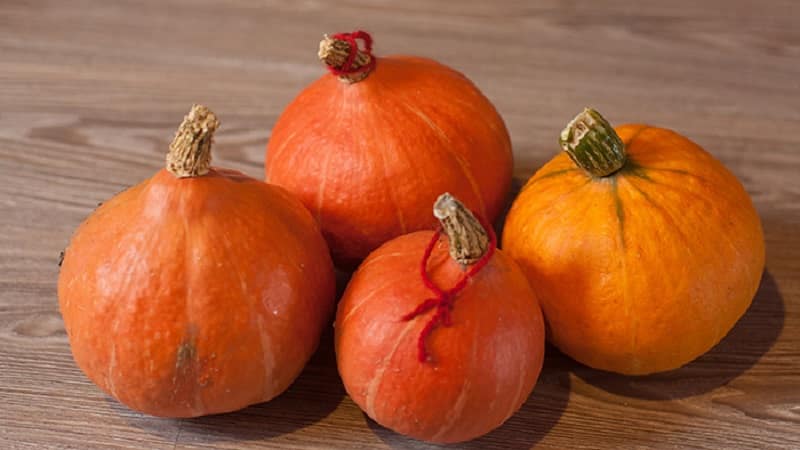
Advantages and disadvantages
Benefits of Hazelnut:
- unusual taste;
- a large amount of pulp;
- high keeping quality;
- immunity to many diseases;
- ease of care;
- compact size.
The hybrid has no disadvantages.
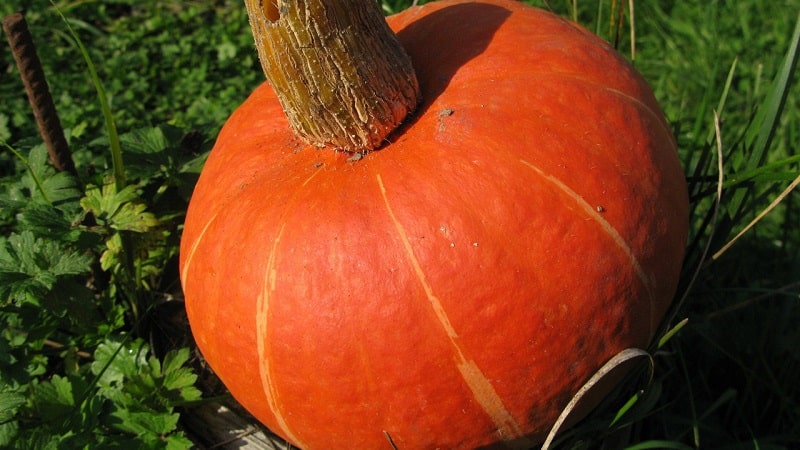
Farmer reviews
Feedback from farmers about Hazelnut pumpkin is mostly positive. Everyone who has tried it loves its unusual taste and ease of care.
Ksenia, Moscow: “I’ve been growing Hazelnut pumpkin for several years now. I like its compact size and unusual taste. Indeed, there is a nutty taste. There are no special problems with growing. I feed it with complex fertilizers and manure. Not sick."
Igor, Voronezh: “I liked the Hazelnut Pumpkin, although I didn’t notice the promised nutty flavor.Not very sweet, so good for preparing second courses. It has a very durable skin. I like to use these pumpkins for roasting meat. At the same time, I don’t scoop out all the pulp. It makes a great side dish."
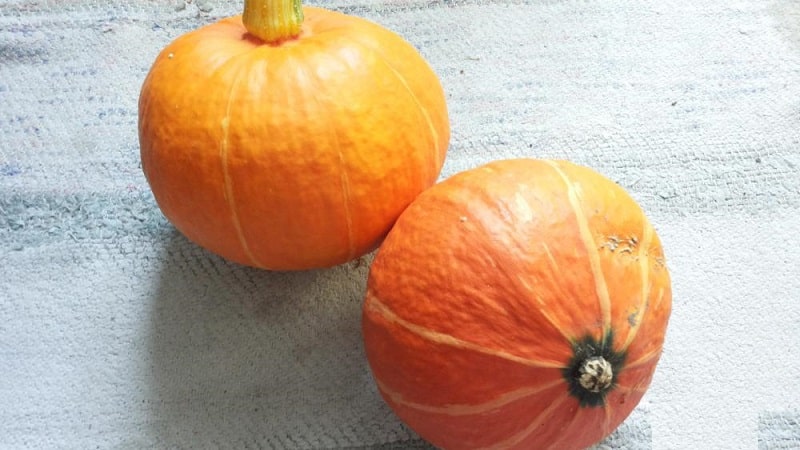
Read also:
The harm and benefits of pumpkin seeds for men.
Traditional methods of treatment with pumpkin leaves: how to use them in the fight against diseases.
Conclusion
Hazelnut pumpkin is a hybrid with an unusual taste. Its dense but tender pulp has a nutty and nutmeg flavor. It is ideal for preparing absolutely any dishes, but is not suitable for juices.
Growing such a vegetable is not difficult. You just need to follow all the watering rules and pay enough attention to fertilizing.